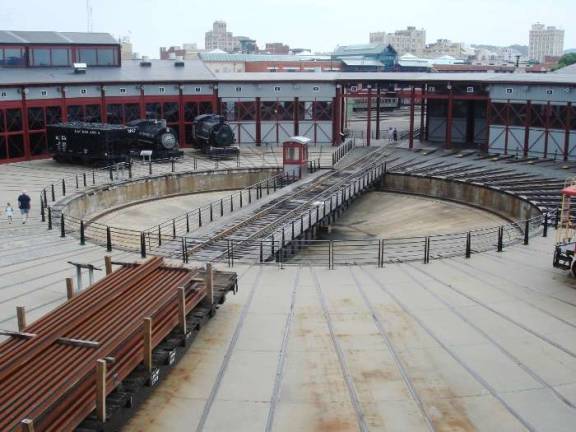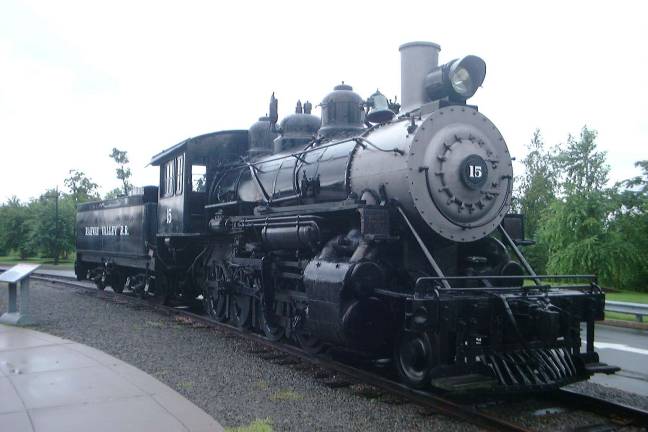Long-hidden history emerging from Steamtown collection


By David Singleton
SCRANTON — Steamtown National Historic Site historian Patrick McKnight donned a pair of archivist gloves and delicately turned the pages of the aged journal in front of him.
The book is already in two pieces, its front cover detached. The gloves and the care are to avoid more damage.
Recorded inside are the corporate minutes of the Liget's Gap Railroad Co. from 1849 to 1853. Better known today by its modern spelling, the Leggett's Gap was the earliest precursor of the Delaware, Lackawanna and Western Railroad and hauled iron rails produced in what would later become Scranton to points north.
“I'm sure if you look through this, you'll find a Scranton or somebody you know," McKnight said, referring to the city's founding fathers, as he eyed the neat, tight cursive flowing across the corporate minute book's pages.
Six years after Steamtown acquired the Liget's Gap volume and millions of other 19 and early 20 century corporate records of the DLandW and Erie railroads from Syracuse University, the massive collection's untold stories are slowly revealing themselves, thanks to often painstaking work by McKnight and teams of volunteers.
“Every day is an adventure," McKnight, 60, said.
At the heart of the collection — and what initially piqued Steamtown's interest in the archives Syracuse agreed to transfer to the historic site in 2012 — are 20,000 glass plate photographic negatives documenting the railroads from around 1900 to roughly 1930.
The vast majority of the negatives are from the DLandW's files and depict not only its rail operations but also ancillary enterprises, including the coal mines it owned and operated in Northeast Pennsylvania; only about a thousand came from the Erie Railroad.
One of the first tasks McKnight and his volunteers tackled after Steamtown took possession of the Syracuse collection was scanning, sorting and indexing the negatives, all of which have now been digitized.
“It was kind of a priority when we got them because pictures are worth a thousand words," he said. “We have millions and millions of words in the documentation we have here, but the pictures tell a lot of the stories. It's one of the more interesting hooks in getting people involved."
With many of the images in the collection unmarked, McKnight said he is constantly trying to better define where the photographs were taken and what they depict. He regularly engages members of the rail-fan community to assist, sending out five to 10 photos at a time to let them “show how smart they are and how dumb I am."
It can be particularly helpful when it comes to DLandW bridges or other rail- or mine-related infrastructure, he said.
“Every now and then, someone stumbles across something and goes, `Oh, wow, I didn't know there were pictures of that,"' McKnight said. “A lot of these pictures have never been seen before."
The Syracuse collection found a home at Steamtown, in part, because it complimented existing components of the historic site's archives, he said.
Sitting at a computer in his office, McKnight pulled up a photo, reproduced from one of the glass plate negatives, of a 16-foot-long model of the Nicholson Bridge, also known as the Tunkhannock Viaduct. DLandW built the model of the concrete bridge and sent it to an industrial exhibition in Germany in 1914, right before the start of World War I.
“It got lost in the war and never made it back," he said.
Steamtown officials know that, he said, because they have correspondence in German from another collection — the DLandW chief engineer's files gathered at Hoboken, New Jersey, in the 1980s — in which railroad officials “are trying to figure out what happened to their model."
Although Steamtown placed a “big emphasis" on the glass plate negatives when it acquired the Syracuse archive, they represent only a small fraction of the overall collection, McKnight said. There are tons — “and I mean literally tons" — of paper documents for both the DLandW and the Erie, plus all of their subsidiaries.
“They generated a lot of paper back then," he said. “Railroads needed to track what they had and what they were doing. They were in business to make money, and when they lost track of what they had and what they were doing, they weren't making money."
Among the documents are copies of correspondence written by the various presidents of DLandW from the 1850s until 1916, including William Haynes Truesdale, who oversaw the railroad from 1899 until 1925.
McKnight said Truesdale was not only a “really sharp businessman" but, unlike his predecessors, he came from a railroading background.
“Truesdale was a true railroader and he sort of pushed the Delaware, Lackawanna and Western into the 20 century," he said. “Truesdale really modernized the railroad."
The DLandW passenger terminal, now the Radisson Lackawanna Station Hotel, was constructed during Truesdale's presidency, as were what is now the General Dynamics plant on Cedar Ave. and many of the older structures at the Steamtown site.
In a major undertaking, National Park Service volunteers scattered around the country are helping McKnight transcribe copies of the more than 100,000 pieces of outgoing correspondence Truesdale wrote between 1899 and 1916.
“It's everything you can imagine," McKnight said. “When he became president, he was swamped with people wanting to come work for him. The railroad also ran coal mines in the area, so it's interesting to see how he developed the mines. When the anthracite strike of 1902 hit, you can see a lot of correspondence going on about that."
A file on a table in McKnight's office is open to a letter Truesdale sent Jan. 13, 1900, to Staver Carriage Co. in Chicago. In the brief letter, Truesdale informs Staver that DLandW is not buying buggies or heavy wagons at that time.
McKnight said he takes photographs of the letters and emails them to his volunteers, who transcribe them. The transcriptions then are returned to Steamtown, where they become part of a word-searchable database. The goal is to get all of Truesdale's correspondence transcribed and into the database so researchers can easily search for names, places or whatever.
“Right now, I have a dozen transcribers signed up," McKnight said. “I could probably use a hundred."
While Truesdale had a lengthy tenure and presided over the railroad during a period of significant growth, McKnight chose to focus on his letters in part for another reason: They are typewritten. The correspondence of the DLandW presidents who preceded him are handwritten.
“Some of it is prettier handwriting and more legible, but the stuff right before Truesdale is like hen's scratching. I actually had one volunteer tell me, `I can read anything.' I sent that to her and she said, `I guess I can't read anything,"' he said, chuckling.
That highlights another challenge presented by the collection. Most of the documents are handwritten, and McKnight said it is getting more difficult to find people who can read even the best handwriting. He finds most high school students and many college students have a hard time deciphering it.
“I've given it a try," he said. “Some of these books have indexes in them and they at least say who the correspondence is going out to. It's a little clearer handwriting in the index, and I might be able to identify if, say, somebody was sending a letter to Abraham Lincoln."
In a room down the hall from McKnight's office, one local volunteer has been meticulously working his way through DLandW's financial correspondence, taking each trifolded document from its original box and flattening it out before recording what it is and putting it into a regular folder.
So far, McKnight said, the volunteer has finished just over 100 boxes of records covering the period from the late 1840s until 1886. There are still about 400 boxes to go.
The flattened documents then go to another volunteer who scans in each one as a PDF file with annotations indicating who sent the correspondence and who received it.
“He's on box No. 3," McKnight said.
The sheer volume of the material means there are many archives, particularly those related to DLandW subsidiaries, that have never been examined.
“I've had people get all excited and say, `I thought you just had DLandW stuff. I didn't know you had some of these others,"' McKnight said, pointing out the records run the gamut from the Hoboken Ferry Co. to land development companies to a hotel advertising firm the railroad owned.
He acknowledges the work of sorting through all the documents Steamtown received from Syracuse will extend long past his retirement, but the historic site has a better understanding now of what is in the collection than it did when the archives arrived stacked on pallets six years ago.
“A lot of this stuff we acquired we have re-foldered and we've expanded the identification, so we can actually find it a little easier, at least the generic date... All of it is basically entered into the computer, at least to the box or ledger level and sometimes to the actual item level," he said.
Both McKnight and Steamtown Superintendent Debbie Conway said the addition of the Syracuse collection solidifies the historic site's standing as a research destination for academics and others interested in Northeast railroading and the region's anthracite mining past.
Describing the glass plate images as “just fantastic," Conway said having that extensive photographic collection especially is a major asset for the site.
“We get a lot of requests and interest for on-site research from people wanting to use that collection in particular," she said.
McKnight said there is still so much to discover in the archives that he sometimes has to force himself to set aside something he's found and take a step back or he wouldn't get any other work done.
“I mean, we have a little bit of everything," he said. “There are just a lot of little eye-openers. It's amazing what you can dig up here. There are just so many little puzzle pieces to the history of the area and the country."